SNOW DAY ON BERGEN & FLATBUSH (1888)
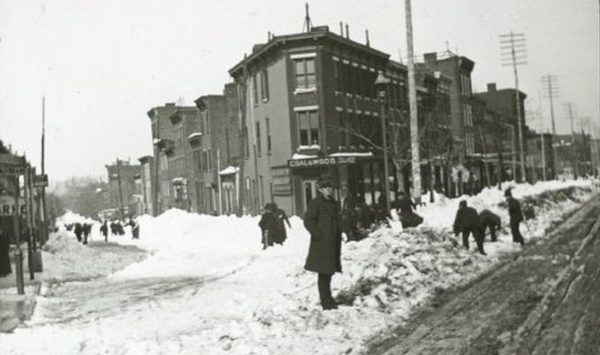
******************************************************************************************************************************** Brownstone Detectives investigates the history of our clients’ homes. The story you are about to read was composed from research conducted in the course of one of those investigations. ******************************************************************************************************************************** Although today was merely a dusting in comparison to the Blizzard of 1888, it gives us an opportunity to look back on what the aftermath of a real snowstorm looked like. In the inset black & white photograph, we see men clearing snow outside of a coal & wood store after the blizzard at the corner of Flatbush Avenue and Bergen Street. We’ve included a Google Maps view of what that corner looks like today. The Coal & Wood shop is now a Gino’s Pizza at 218 Flatbush Avenue. Follow @BrownstoneDetec Share ———————————————————————————————————————– The Brownstone Detectives Brownstone Detectives is a property research agency. Our mission is to research, document, and save the histories of our clients’ historic properties. From this research, we produce our celebrated House History Books. Each book is fully cited, featuring detailed narratives and colorful graphics, and is designed to bring the history of any house to life. Contact us today to begin discovering the history of your home.
THE LOST ART OF MOVING HOUSES (1900)
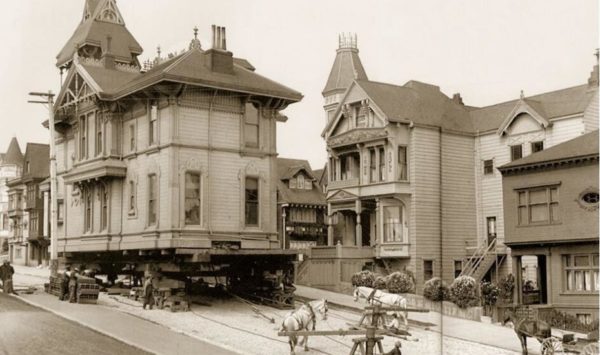
******************************************************************************************************************************** Brownstone Detectives investigates the history of our clients’ homes. The story you are about to read was composed from research conducted in the course of one of those investigations. Do you know the history of YOUR house? ******************************************************************************************************************************** An article in the 28 March 1900 edition of the Brooklyn Daily Eagle caught our eye the other day. It detailed an old practice of moving houses, and it took place in a time when the economics were such that their transport to another lot made more fiscal sense than tearing them down wholesale. In this story, however, the time it took to move this particular house took a toll on the neighboring residents. And, at one point, they gathered to tear the house down, themselves… THE HOUSE IN THE STREET The story took place in the early part of 1900 in Flatbush at the corner of Flatbush Avenue and Linden Boulevard. The subject was a frame structure that was being moved from that corner, although not quickly enough for local residents who protested the house’s temporary location on Linden Boulevard. And by “on Linden Boulevard,” we mean on the actual roadway itself. “A frame building stands in the middle of Linden boulevard, at its junction with Flatbush avenue. The building bears the sign of Vanderveer & Williamson, real estate agents,” the reporter started his story. Vanderveer & Williamson, we discovered – through combing the newspaper’s archives – were Adrian Vanderveer and Adrian N. Williamson, who had, by this point, had […]
HAS YOUR BROKER BEEN FOOLING YOU? (1905)
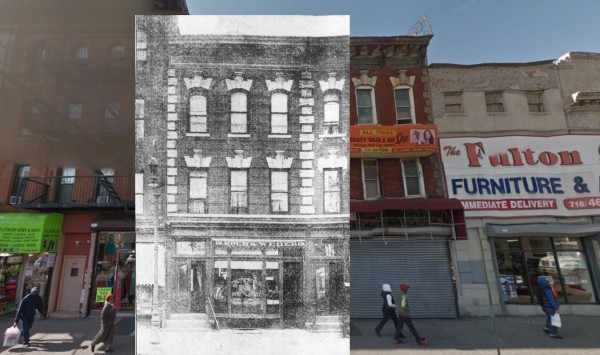
******************************************************************************************************************************** Brownstone Detectives investigates the history of our clients’ homes. The story you are about to read was composed from research conducted in the course of one of those investigations. Do you know the history of YOUR house? ******************************************************************************************************************************** In 1905, No. 838 Flatbush Avenue was only a few years old. But it was already on its third tenant. The Brooklyn Daily Eagle opened its Flatbush office at No. 838 (today, No. 834) that year, forcing Weber & Koch realtors out the door. The building had been constructed by Captain Henry Hoffman. Hoffman, referred to as captain from his sailing days, was the sole surviving member of the crew of the schooner America which had brought the America‘s Cup to the United states in 1851. In business life, Hoffman was a big man in New York society, having been a millionaire coal merchant, though, in 1905, and reputedly (according to many sources – amongst them the Daily Eagle) the wealthiest man in Flatbush at the time. Hoffman had originally expected to use the site for the real estate dealings he dabbled in. Soon after building the structure, however, Hoffman would sell and move on. The new owners would be the borough’s premiere newspaper, the Brooklyn Daily Eagle, which would maintained the office as a branch of the newspaper up until around the late 1920s. In 1918, however, part of the building was taken up by another organization. The Flatbush Chamber of Commerce established itself there. All this from an unassuming […]
WHEN BROOKLYN’S SUBWAYS WERE CAVING IN
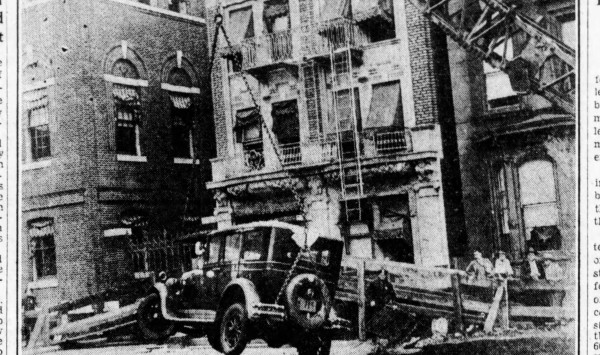
Back in the day, when subways were being dug throughout the city, cave-ins were a common occurrence. Very often these cave-ins were caused by water leakage or seepage, or heavy rains. As such, the City began to run drainage water in overhead tubes to keep the area near the subway digs in-tact. Follow @BrownstoneDetec ———————————————————————————————————————– The Brownstone Detectives The story you have just read was composed from historical research conducted by The Brownstone Detectives. It was uncovered during the extensive research that our clients commission us to perform on their historic homes, research which culminates in the production of one of our celebrated House History Books. If you are interested in discovering the history of your home, contact us today.
ATLANTIC TERMINAL – 1910 vs. 2018
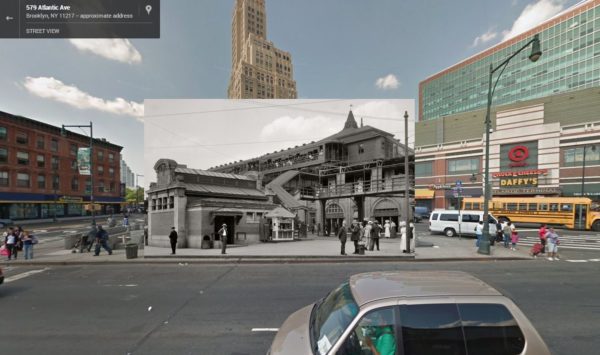
******************************************************************************************************************************** Brownstone Detectives investigates the history of our clients’ homes. The story you are about to read was composed from research conducted in the course of one of those investigations. Do you know the history of YOUR house? ******************************************************************************************************************************** We found a photograph taken at the “Atlantic Avenue subway entrance,” circa. 1910, and superimposed it onto an image taken from the same location, circa. today (courtesy Google Maps). The old picture shows an elevated railway and streetcar tracks in the background – the elevated railway is now underground and the streetcar has been replaced by city busses. If you look closely at the train cars, you can see that they are open on the sides, showing the time of year the photograph was taken. Also telling of the period (and the time of the year) are the boaters that the men are wearing – they were en vogue in mean’s spring/summer fashion at the time. There are also a couple of policemen, looking very much like London “bobbies” or “Keystone Cops” with their distinctive helmets. Notice anything else? Follow @BrownstoneDetec Share ———————————————————————————————————————– The Brownstone Detectives Brownstone Detectives is an historic property research agency. Our mission is to document and save the histories of our clients’ homes. From our research, we produce our celebrated House History Books and House History Reports. Contact us today to begin discovering the history of your home.
SUBWAY DIGGING – GRAND ARMY PLAZA (1914)
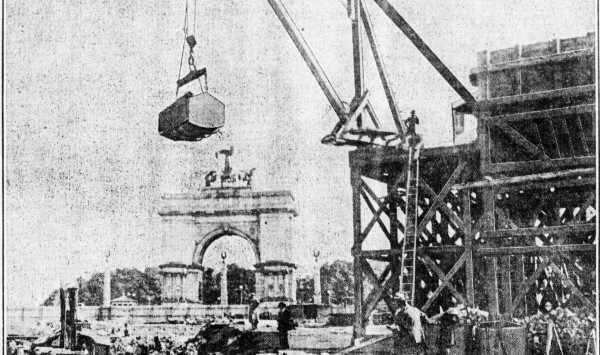
“Dirt is beginning to fly with telling effect in the excavations for the extension of the subway through Flatbush Avenue and out Eastern parkway,” noted the Brooklyn Daily Eagle in their 30 August 1914 edition. “The Above picture shows the big steam shovel at work close to the sailors and soldiers Monument at the Plaza of Prospect Park. Which is seen in the background. This excavation of the present subway will be constructed faster than the Fourth Avenue line has been because there are neither troubles about obtaining title to abutting lands nor the physical difficulties which reset the Fulton Street section of the Fourth Avenue line.” Follow @BrownstoneDetec ———————————————————————————————————————– The Brownstone Detectives The story you have just read was composed from extensive historical research conducted by The Brownstone Detectives. Our clients commission us to investigate the history of their – or their clients’ – historic properties. From our findings, we produce their very own hardbound House History Books. Our books are professionally written and laid out, containing illustrated and colorful narratives that bring the history of any house to life. Contact us today to begin discovering the history of your home.
TILTING AT FLATBUSH WINDMILLS (1879)
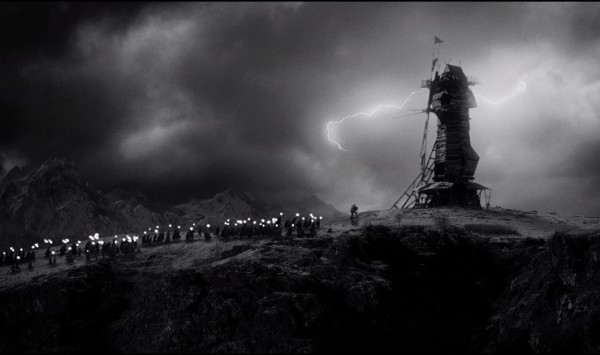
******************************************************************************************************************************** Brownstone Detectives investigates the history of our clients’ homes. The story you are about to read was composed from research conducted in the course of one of those investigations. Do you know the history of YOUR house? ******************************************************************************************************************************** It was iconic like the Williamsburg Bank building (1 Hanson Place) at Flatbush Avenue. It had stood on the same Flatbush farm for 75 years – a relic of our Dutch past and a connection to our Brooklyn roots. Most Brooklyn residents had never seen it – but everyone knew of it. It had even made such an impression on the psyche of 19th century Brooklynites that socialite Gertrude Lefferts Vanderbilt included its destruction in her book, The Social History of Flatbush. And, incredibly, it had even had a special significance to the “colored” people of New York and Brooklyn, as it was used during the Civil War draft riots of 1863 – which had spread from New York to Brooklyn – to shelter much of the city’s black population. By the late 19th century, though, it was no longer operable as a windmill. As landmarks went, however, no one could relegate the structure to any sort of second class status. It was a Brooklyn landmark through and through. But all of that changed on a single night in 1879 when, through the bottom windows, the Vanderveer windmill began to spout flames. CONFLAGRATION! The flames rose so high, filling the eastern expanse of the night’s horizon, that people in the center […]
SO A TAXICAB JUMPS INTO A FOUNTAIN… (1909)
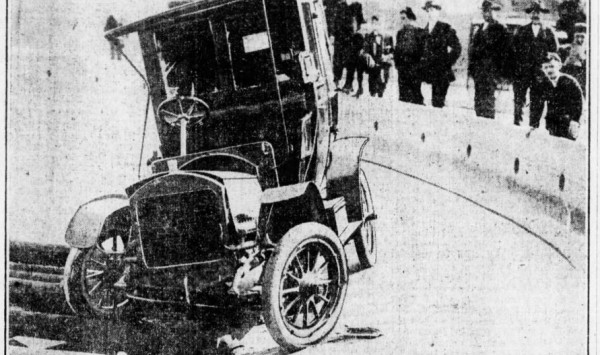
******************************************************************************************************************************** Brownstone Detectives investigates the history of our clients’ homes. The story you are about to read was composed from research conducted in the course of one of those investigations. Do you know the history of YOUR house? ******************************************************************************************************************************** When Brooklyn woke up one April morning in 1909, there in Prospect Park Plaza’s “Electric Fountain” sat a little blue taxicab. To many, the thing appeared as though it had always belonged there. Some wondered whether they’d simply not noticed it all along. But others realized that something was wrong. Something was certainly wrong. THE CASE OF THE IMPETUOUS TAXICAB It seems as though the Grand Army Plaza has always had a fountain. But back when the plaza was called Prospect Park Plaza and it encompassed a larger amount of land, that fountain was much larger and took up much more space. The fountain was then what was called an “electric fountain,” and after it was installed it would attract people by the thousands each year when the lights and the water were turned on. One year, after the winter had passed and after the water was supposed to have filled the reservoir, with the jets darting, and the lights dancing, the fountain sat silent. So, as popular as the fountain was to Brooklyn, the reporters of the city had descended upon Parks Commissioner Kennedy about it’s inactivity. And in the midst of the hubbub – came the crash. HOW IT ALL CAME ABOUT It was 11:30 on a Sunday night […]
STRAIGHTENING A CROOKED CHURCH (1904)
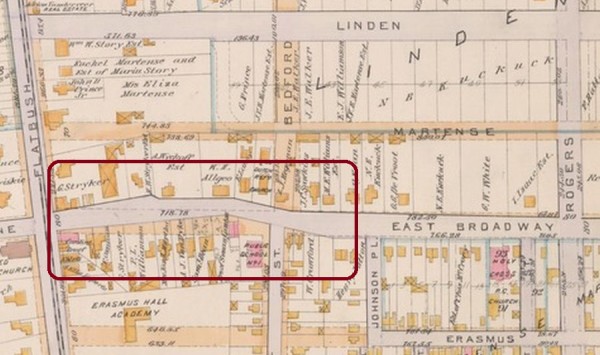
******************************************************************************************************************************** Brownstone Detectives investigates the history of our clients’ homes. The story you are about to read was composed from research conducted in the course of one of those investigations. Do you know the history of YOUR house? ******************************************************************************************************************************** “You can’t drive straight down a crooked road.” So goes the old saying which implies the difficulty of staying the course in precarious surroundings. And the saying proved to be of true portent in the center of Flatbush in 1904. BUT TO BEGIN AT THE BEGINNING… Before the Town of Flatbush was unceremoniously subsumed into the City of Brooklyn, it was still a rustic expanse of farmland, dirt roads, and farmers. When that great event happened in 1894, one of the challenges Brooklyn faced – which Brooklyn had taken on some 50 years earlier itself – was making the Flatbush roadways congruent with the rest of Brooklyn’s streets and avenues. This challenge would prove to be even more decidedly troublesome as the Department of Streets began to study the lay of the farmlines which made up the old town. Nearly all of them – in the 1600s – were set at an angle. CROOKED CHURCH One of the roadways which ran alongside several of these farms was Church Avenue. Church was named after the Flatbush Reformed Protestant Dutch Church, which sat at the corner of Church and Flatbush avenues. As Church Avenue (formerly East Broadway) passed Flatbush and moved in an easterly direction, the avenue, according to a current newspaper article, […]